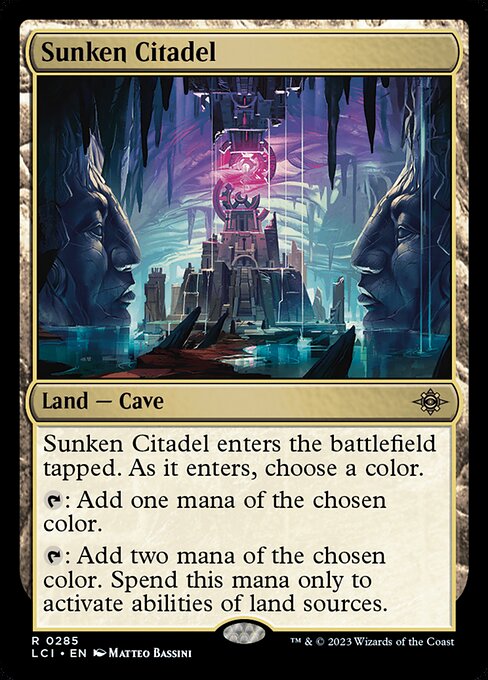
Image courtesy of Scryfall.com
Sunken Citadel and Land Art: Trends Across MTG Decades
Magic: The Gathering has always been a mirror of its era—an evolving tapestry where the art style on a single card can whisper about printing technology, cultural mood, and the designers’ push to make gameplay feel tactile in a digital age. Sunken Citadel, a rare land from The Lost Caverns of Ixalan, is a particularly juicy case study. Its cavernous motif sits at the crossroads of nostalgia and novelty: a modern piece that still nods to the ancient nature of “land as character.” 🧙♂️🔥💎⚔️ The card’s text is concise, but its implications reverberate through how art and mechanics influence how we experience color and mana in play.
Looking back across the decades, early MTG art leaned toward bold, high-contrast line work and painterly textures. Lands were often about place and tone—the color identity of a map rather than a narrative centerpiece. As printing technology evolved, the 2000s and 2010s ushered in digital painting, photo-real textures, and more panoramic, cinematic landscapes. Sunken Citadel’s color-agnostic frame (it doesn’t show a single mana symbol on the card itself) belies a deliberate design choice: the land can become any color the player desires, a concept that harmonizes with the era’s growing emphasis on multi-color strategies and color-splash archetypes. 🎨
When we stride into the 2020s and beyond, art direction often blends realism with abstraction and clever environmental storytelling. Sunken Citadel exemplifies this: the art hints at a submerged fortress whose walls glow with the hues of every color wheel. This mirrors a broader trend in MTG where galleries celebrate diversity of color pie interpretations, while still grounding them in evocative, collectible imagery. The Lost Caverns of Ixalan art direction leans into moody lighting, mineral textures, and architectural geometry that feels almost like a cinematic location scout. It’s a reminder that art isn’t just decoration—it’s a set of visual rules that informs how players parse a card’s function at a glance. 🧭🎲
This land enters tapped. As it enters, choose a color.
{T}: Add one mana of the chosen color.
{T}: Add two mana of the chosen color. Spend this mana only to activate abilities of land sources.
That last line—spending the two-mana option only to activate land-based abilities—is a perfect example of design marrying theme and utility. The color flexibility mirrors the card’s art: a fortress that can belong to any color identity, yet remains a tactical anchor in the player’s mana economy. It invites players to imagine a world where a submerged citadel could power green ramp with forest magic or empower blue-leaning control plans, all while reinforcing the land theme as a creative engine. This kind of semantic alignment between image, flavor, and rules is a throughline in art direction that has grown more pronounced with each passing decade. 🔥⚡
Two Decades of Frame and Palette Shifts
From the 1990s through the 2010s, changes in frame design—font, border, watermark placement—affected how color and atmosphere read on the page. Early frames emphasized stark silhouettes and dramatic skies; later frames embraced subtler gradients and layered lighting. Sunken Citadel’s artfully muted cavern tones—dark blues and earthen browns with sudden glints of mineral glow—fit the modern aesthetic that players now expect: a high-resolution, immersive look that still respects the print heritage. The piece’s color identity, though it’s a land card, visually channels the idea that the battlefield isn’t bound to one hue—it’s a multicolor possibility rendered tangible by the card’s ability to produce any color of mana when tapped appropriately. 🎨
In terms of lore and flavor, art across decades has shifted from explicit fantasy geography to more atmospheric worldbuilding. Caverns, ruins, and forgotten places became stage sets for multi-layered storytelling. Sunken Citadel sits squarely in that tradition: a location that suggests ancient civilizations, sea-rise catastrophes, and hidden power—an icon for players who love flavor as much as function. The art direction choices—lighting, texture, and architectural geometry—also align with the era’s broader trend toward environmental storytelling and cinematic composition. 🧭
Matteo Bassini and the Ixalan Palette
The artist behind Sunken Citadel, Matteo Bassini, brings a distinctive polish to this piece: crisp linework, luminous mineral sheen, and a sense of depth that rewards slow inspection. The Lost Caverns of Ixalan—its set name—encourages exploration of color as a narrative tool. Sunken Citadel’s ability to produce any color mana underscores a design philosophy where color identity is fluid and strategic, not constraint-bound. Bassini’s rendering communicates both the weight of a centuries-old ruin and the spark of a card that can adapt to your deck’s ambitions. For collectors, the rarity designation and the foil option (present in the card data) add tangible value, but the real treasure is the way the image invites you to test your imagination every time you draw. 💎
In a broader cultural sense, art trends across decades reflect MTG’s growth as a pastime that rewards both memory and experimentation. We’ve moved from “lands as background scenery” to “lands as artful ambassadors of color strategy.” Sunken Citadel is a standout example of how a single card can embody that arc—a modern classic that nods to the past while guiding us into a future where color is a party guest that nobody wants to eject from the table. 🧙♂️🎲
For readers who enjoy the tactile experience of mixing aesthetics with play, the combination of a vivid, color-agnostic mana production mechanic and a striking cavern motif makes Sunken Citadel a compelling centerpiece for both casual reminiscence and competitive contemplation. If you’re scheduling a themed Commander night or building a multicolor shell that truly emphasizes flexibility, this land is a reminder that artistry and function aren’t strangers—they’re allies at the table. ⚔️🎨
Custom Rectangular Mouse Pad 9.3x7.8in Non-Slip Desk Mat